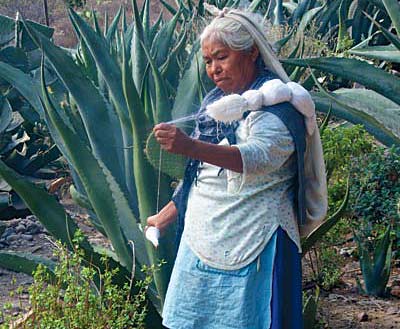
It has been a long time in the making and a lot of effort to make it happen, but , as usual, with passion and determination (together with a lot of stubbornness ) I managed to get things organised and the result is…AMAZING! You know everytime I think of doing something special, finding some rare sheep breed, reading up about the cultural importance it has had and how much history is involved , I am grateful to be and always be an anthropologist and artist in my heart and soul... How important it is to recognise that even in the past things have evolved by trade and combining forces and learning from one another.
My Native American heritage and my travels all around the world seeing so many different cultures and arts leaves me in awe and it will never cease to amaze me. I have spend a lot of time in Mexico, in and around Toluca and Pueblo and even more time soaking up the wonders of Yucatan and Oacaca. I knew that there was trade in the far past between the Navajo Nation and the Aztec, Mixtec and Mayan communities, especially when weaving was concerned. So that is when I thought of this new blend combining a plant fibre used by both cultures and the ever important Churro sheep of the Navajo Nation: into existence came m y quest to create a blend of both cultures that have meant so much to me in my fibre art: the Agave plant (Maguey) and the Navajo Churro. Finally I have finished all the prepping and blending of these fibres together with some magical Angora Bunny and cashmere goat, making today the first announcement of the “Frida” Adventure, named after Frida Kahlo, artist extraordinaire and an exhibition of her paintings is coming to Sydney from June to October!
If you can, go see it and if not, watch the movie “Frida” . Such a powerful woman and artist. How a life full of pain and adversity can lead to create so much colour and art. An Inspiration. That is why I decided to name this adventure “Frida”, a recognition not only of her art, but also of the strength of combining your roots with the ”Now” and never let anybody or anything hold you back.
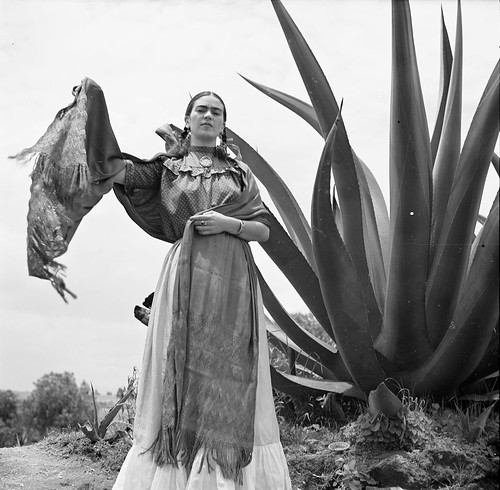
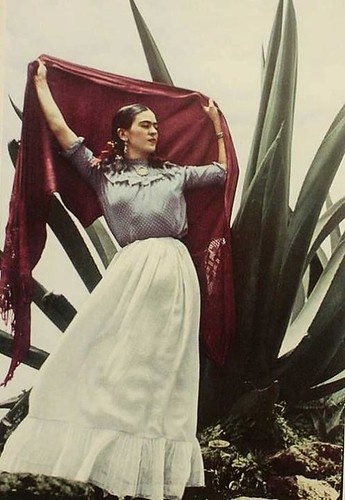
My Native American heritage and my travels all around the world seeing so many different cultures and arts leaves me in awe and it will never cease to amaze me. I have spend a lot of time in Mexico, in and around Toluca and Pueblo and even more time soaking up the wonders of Yucatan and Oacaca. I knew that there was trade in the far past between the Navajo Nation and the Aztec, Mixtec and Mayan communities, especially when weaving was concerned. So that is when I thought of this new blend combining a plant fibre used by both cultures and the ever important Churro sheep of the Navajo Nation: into existence came m y quest to create a blend of both cultures that have meant so much to me in my fibre art: the Agave plant (Maguey) and the Navajo Churro. Finally I have finished all the prepping and blending of these fibres together with some magical Angora Bunny and cashmere goat, making today the first announcement of the “Frida” Adventure, named after Frida Kahlo, artist extraordinaire and an exhibition of her paintings is coming to Sydney from June to October!
If you can, go see it and if not, watch the movie “Frida” . Such a powerful woman and artist. How a life full of pain and adversity can lead to create so much colour and art. An Inspiration. That is why I decided to name this adventure “Frida”, a recognition not only of her art, but also of the strength of combining your roots with the ”Now” and never let anybody or anything hold you back.


Frida in a photo session with a majestic Agave plant
You may know I have a soft spot for Navajo Churro sheep and the navajo rugs. Spending a substantial time of my childhood spinning and rugs being woven and the stories being told. I guess that is what is really the most important: the stories that are so intrinsically woven into the yarn and the rugs and the making of warps and baskets.
It is not only a craft , but also a way of translating how we look at the world and incorporate its magic into a two dimensional framework. Even the way that we see looms are different: the ropes to hold the warp threads are the thunder and the the warp itself is the rain falling down from heaven to earth. I was always taught never to weave when there was a lightning storm because of that.
Ofcourse sitting at a large loom , exposed to the elements , is never an extremely good idea when a big lightning storm hits, but you see how it all interweaves into ones life. Everything has a meaning, everything around you is transformed and has its own magic. Just look at how the corn rug below resembles reality...abstract and yet so similar.
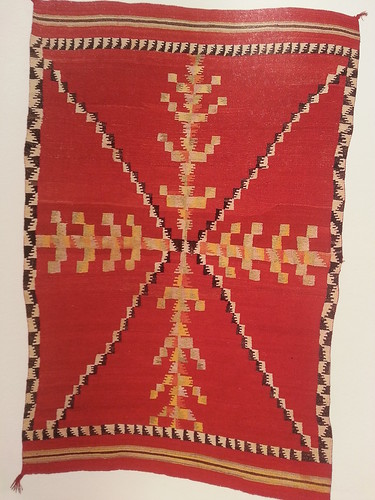
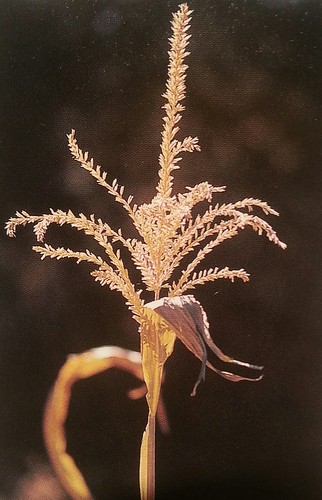
There are so many things going on in a navajo rug, whether it be something minuscule woven into certain spots like a feather into a horse blanket to make sure that the horse is fast as an eagle, or bits of hair or plants, all have their meaning.
In the old days , the midwife collected corn pollen and then a horny toad was found and the pollen was put on its head and mouth. It was an extremely good omen that the toad spat out the corn mush and often that is why these kinds of ceremonial birthing rugs have yellow woven in to them, much like this one here:
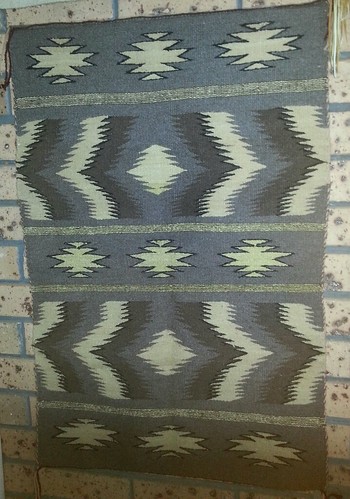
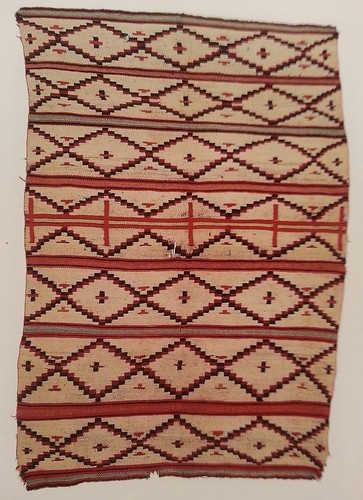
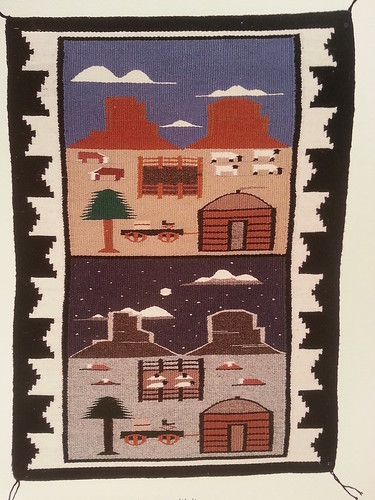
It is not only a craft , but also a way of translating how we look at the world and incorporate its magic into a two dimensional framework. Even the way that we see looms are different: the ropes to hold the warp threads are the thunder and the the warp itself is the rain falling down from heaven to earth. I was always taught never to weave when there was a lightning storm because of that.
Ofcourse sitting at a large loom , exposed to the elements , is never an extremely good idea when a big lightning storm hits, but you see how it all interweaves into ones life. Everything has a meaning, everything around you is transformed and has its own magic. Just look at how the corn rug below resembles reality...abstract and yet so similar.


There are so many things going on in a navajo rug, whether it be something minuscule woven into certain spots like a feather into a horse blanket to make sure that the horse is fast as an eagle, or bits of hair or plants, all have their meaning.
In the old days , the midwife collected corn pollen and then a horny toad was found and the pollen was put on its head and mouth. It was an extremely good omen that the toad spat out the corn mush and often that is why these kinds of ceremonial birthing rugs have yellow woven in to them, much like this one here:



Night times; daytime rug
Weaving and spinning yarn is more than just a craft to me and the Navajo people. It is an expression of culture. The yarns are used to weave the rich history and tell the stories and this history is passed down from generation to generation. There was lots of trade between the Aztic, Mixtec and Navajo people, and the weaving tradition of the Navajo was certainly influenced by it.
The rugs sing a song, tell a story and that is what makes them so magical. If the past and the stories are forgotten, then the rugs won’t mean anything. Not only are there rugs but also other items that are woven : baskets and so called Tump line weavings ( an object woven with a warp of Agave and wool or just agave fibres) , worn over the head to help carry heavy loads) Here is a photo of one that survived from the pre-columbian times (= pre 1500s)
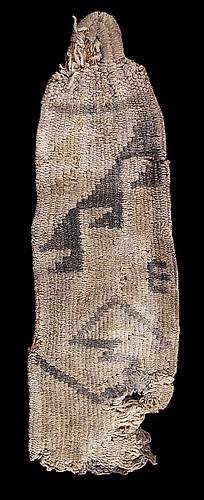
There is so much to tell and so little time. I may have to do another blog about more of the magic in the rugs and more about story telling!
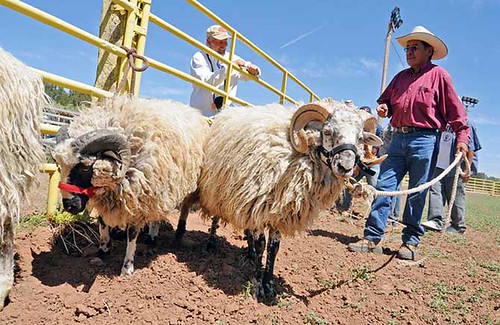


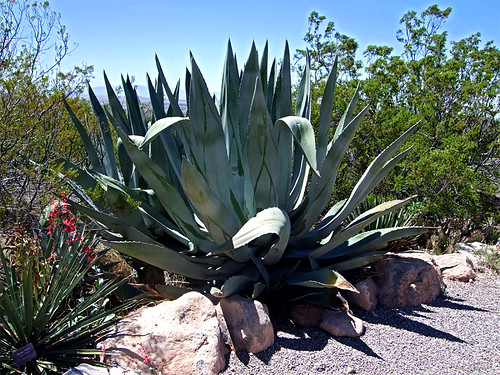
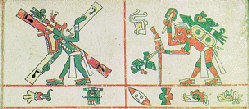
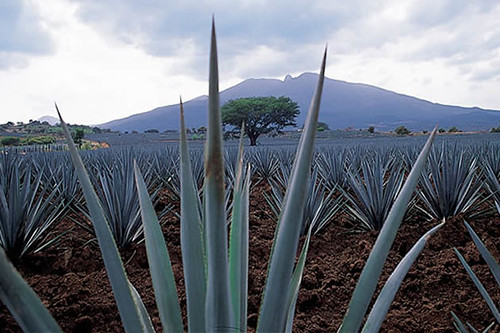
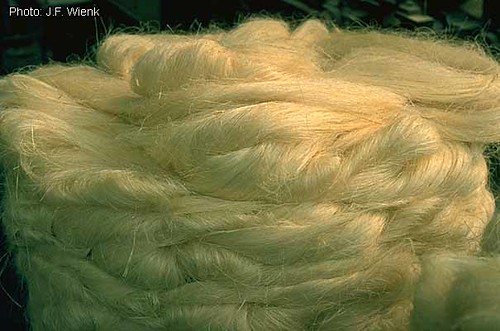
The rugs sing a song, tell a story and that is what makes them so magical. If the past and the stories are forgotten, then the rugs won’t mean anything. Not only are there rugs but also other items that are woven : baskets and so called Tump line weavings ( an object woven with a warp of Agave and wool or just agave fibres) , worn over the head to help carry heavy loads) Here is a photo of one that survived from the pre-columbian times (= pre 1500s)

There is so much to tell and so little time. I may have to do another blog about more of the magic in the rugs and more about story telling!
But now back to the Adventure at hand : The new passionate blend of FRIDA, combining Agave ( used for weaving , making tequila and Mezcal: pleqse do not try to drink this blend ;-) ) and the Navajo Churro rare sheep breed.
Navajo Churro sheep are very special just like the history they have : The Navajo call them "the Old Ones" and see the Churro sheep as a gift from the Gods. The wool from these sheep are the basis of the Navajo Weaving and also is a wonderful fibre to make socks and ponchos. The sheep were nearly wiped out during the tribe's forced relocation in the 1860s and again in the stock reductions of the 1930s: federal agents just went from hogan to hogan and shot a large percentage of the livestock and horses, more than 250.000 animals were killed and the Churro sheep were almost extinct with fewer than 700 head by 1990! But they are making a comeback, due to the efforts of the Navajo Sheep Project so they can return to their historic place and purpose among the Navajo and that it can benefit the Navajo People. The hand dyed tops that I am offering you here are blends of soft white Churro fleece with Angora Bunny: it makes for a wonderful mix and will make the most wonderful yarn, suited for socks and outerwear as well as sweaters. The Bunny and the Cashmere added to the Churro makes it very soft to handle and very easy to spin.

The Agave , orf the Maguey as it is also called, has lots of different uses. Archeologists have found evidence that agave were used for food as far back as 9,000 years ago. The agave plant was used for cloth and fermented drink for at least the past 2,000 years. Agaves grow in a remarkable range of terrains and climates. They are found in forests, hillsides, arid plains, deserts and sea coasts, at altitudes extending from sea level to 2,400m (approx. 8,000 ft.).They can survive temperatures ranging from -9 to +41 degrees Celsius (about 15 to 106 degrees Fahrenheit ).
Agaves were the source of many essential items, including fibres for clothing, poultices for wounds, medicines, poisons for arrowheads, building materials and food. As food, the use dates back about 11,000 years based on archeological remains of cooked agave in pits. Even today, agave fibre is used for cloth and paper, although not nearly as much as the industry produces as waste from the tequila production. The agave provided so many essential materials and that it became known as El Arbol de las Maravillas (The Tree of Wonders).





Many Pre-Columbian people in Mesoamerica cultivated the agave. Domestic agaves included (popular names in parentheses): Agave zapota (sapodilla), Agave atrovirens (maguey), Agave fourcroydes (henequen), Agave latissima (maguey). Agave mapisaga (maguey). Agave sisalana (sisal) and Agave tequilana (tequil maguey).
In about 2,000 BCE, maguey was grown in Tula, Tulancingo and Teotihuacan, where obsidian scrapers have been found, suggesting the agave was used for aguamiel or pulque. The ancient Aztec riddle asked "What points its finger at the sky?" and the riddle's answer is "the Maguey Thorn."
When the Conquistador Hernan Cortez wrote to King Carlos V of Spain in 1520, he noted, "honey is also extracted from the plant called maguey, which is superior to sweet or new wine; from the same plant they extract sugar and wine, which they (the natives) also sell." In The Agaves of Continental North America, Howard Scott Gentry wrote, The hunting and gathering tribes had good reason to regard agaves with special attention, because agaves supplied them with food, fibre, drink, shelter, and miscellaneous natural products. Protection may have been one use, for when planted around a cottage, the larger species make armed fences, a common practice in modern Mexico. While much about the first beginnings of agriculture will always remain obscure, there is a great deal now known about the history of man-agave relationship.

In about 2,000 BCE, maguey was grown in Tula, Tulancingo and Teotihuacan, where obsidian scrapers have been found, suggesting the agave was used for aguamiel or pulque. The ancient Aztec riddle asked "What points its finger at the sky?" and the riddle's answer is "the Maguey Thorn."
When the Conquistador Hernan Cortez wrote to King Carlos V of Spain in 1520, he noted, "honey is also extracted from the plant called maguey, which is superior to sweet or new wine; from the same plant they extract sugar and wine, which they (the natives) also sell." In The Agaves of Continental North America, Howard Scott Gentry wrote, The hunting and gathering tribes had good reason to regard agaves with special attention, because agaves supplied them with food, fibre, drink, shelter, and miscellaneous natural products. Protection may have been one use, for when planted around a cottage, the larger species make armed fences, a common practice in modern Mexico. While much about the first beginnings of agriculture will always remain obscure, there is a great deal now known about the history of man-agave relationship.
The main source of food in agave is the soft starchy white meristem. in the short stem and the bases of leaves, excluding the green portion. As the plant matures the starch and sugar content of these organs increases, as does their palatability. Some species and varieties are more palatable than others; those with high sapogenin content and other toxic compounds were generally known and avoided. The young, turgid, tender flowering shoot of most species is edible, as are the flowers of many. The early agriculturist doubtless selected only the sweet sorts for cultivation. Since merely supplying heat converts the starches to sugars, the Indian cooked the softer parts by direct fire or with hot water. "Cooking appears to have been largely of the roasting type, with the outside frequently charred, and the interior still raw. This is true of such plants as Ceiba, Agave, and Opuntia, though they appear to have been eaten raw almost as frequently" (Callen, 1965). Charring of agave flowering shoots by laying them in the fire or in hot coals and ashes overnight was still observed among the backcountry Mexicans in the 1970s, especially to appease hunger on longer journeys. From the time the Mexicans had pots, these flowering shoots were probably boiled, a practice extended to modern times in Mexico. A more sophisticated or communal method for cooking agave was pit baking, which became universal, at least north of Mesoamerica, and which has been mapped and fully discussed by Castetter et al. (1938).
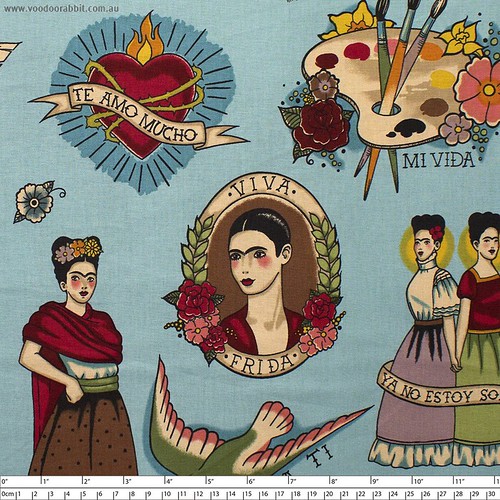
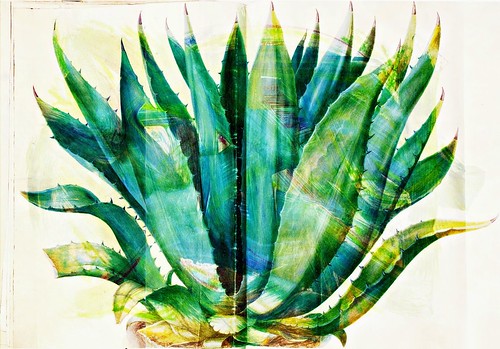

 the natural tops in all their yummy softness and strength -
the natural tops in all their yummy softness and strength -
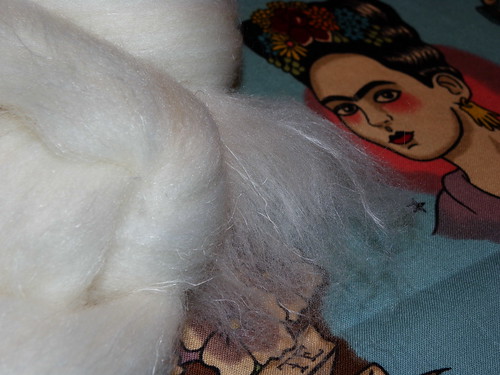
Grandvalley Spinners and Weavers Spin in
Tapscott Hall, Corner Cambridge and Montrose rd, Montrose
The Aztecs used agave fibre in the manufacture of an all-purpose sack called an 'ayate.' In 1531 an ayate was imprinted the image of the Virgin of Guadalupe, since then the Patron of Mexico. In Hidalgo, the Otomis still make fabric from the agave; the men and boys separate fibre from leaves while the women and girls do the weaving.
Prehistoric and historic Indian archeological sites in the Southwest USA show evidence for agave roasting pits, as well as some evidence for agave agriculture. Prehistoric peoples in the Sonoran Desert may have transported agave pups from as far away as Mesoamerica (the great city states in southern Mexico) and may have planted tens of thousands of these agaves in fields that covered square miles in the northern Tucson Basin. The Arizona-Sonoran Desert Museum internet site says the Indians of the Hohokam Puebloan tradition cultivated the Hohokam agave in areas that covered hundreds of thousands of acres: "All of the agave populations from Caborca, Sonora, to New River, Arizona, are so similar that they may be one genetic clone.” Agave was considered sacred by many Pre-Hispanic people. The oldest records come from the Aztec codex, the Tonalmatl Náhuatl, ("Aztec pilgrim's papyrus"), which tells the story of the Mexican people. According to the codex of Nutall, Laud, Florentino and Mendocino, natives had many different uses for agave and its sub-products: food, threads, needles, shoes, roof tops, clothes, nails, weapons and paper among others. The seeds have been ground into powder to make bread or to thicken soup.
In 1577, the Spanish explorer Francisco Hernández wrote about the maguey in the central highlands of Mexico: "As a whole (maguey) can be used as fuel or to fence fields. Its shoots can be used as wood and its leave as roofing materials, as plates or platters, to make paper, to make cord with which they make shoes, cloth, and all kinds of clothes…. From the sap…they make wines, honey, vinegar, and sugar…From the root, they also make very strong ropes which are useful for many things. The thicker part of the leaves as well as the trunk, cooked underground…are good to eat…There is nothing which gives a higher return."
The agave is still used as food today, although it is not as critical to the natives as it was in the past. Agave syrup or nectar (aguamiel) has always been popular in Mexico, but in the past decade has become popular in the health food circles because it provides a good alternative to cane sugars that diabetics can also tolerate.
For millennia, the Hnahnu people used the agave as a source of material to produce more 100 different products including fibres for weaving, brushmaking and other crafts, construction materials, soap, small furniture, toys, ornaments, food and beverages, paper, medicinal products, firewood and even boundary markers in the countryside. The Hnahnu retain a deep traditional knowledge of the life-cycle, characteristics and uses of the agave.
Agave is still used as medicine, particularly in boticas - pharmacies - usually in alternative medicine boticas that offer natural or homeopathic remedies, often selling them beside religious icons and images on the same shelf. One botica online promises agave essence will cure "emotional immaturity, aggressive conduct, impatience, fatigue and premature aging. Before the mid-1800s, there were a dozen agave species used for tequila. But the producers were specializing, growing those that made the best economic as well as aesthetic product.
By the 1870s, the indigenous people of Mexico had so refined their cultivation practices that physiological ecologists of today have barely bettered them. By the 1870s tequila was reduced to the monoculture of blue agaves. In March, 2007, scientists at the University of Guadalajara have announced they believe the blue agave contains compounds that may be useful in carrying drugs to the intestines to treat diseases such as Crohn's disease and colitis.
Perhaps the biggest potential market for agave food products today is the growing agave nectar or syrup market. Agave syrup consists primarily of mostly the easily digested fructose and s smaller percentage of glucose, the amounts depending on the producer. It is sold as a sugar substitute in many health and grocery stores (agave syrup is three-four times sweeter than table sugar). While similar to honey, agave nectar's glycemic index is only 27, compared to honey at 83, which means it is absorbed more slowing into the bloodstream.
And ofcourse, the Agave is also used to produce Mezcal and Tequila !
But enough of sugar and other contents, I assure you that spinning this fibre blend does not impact negatively on your calory intake..lol .
Prehistoric and historic Indian archeological sites in the Southwest USA show evidence for agave roasting pits, as well as some evidence for agave agriculture. Prehistoric peoples in the Sonoran Desert may have transported agave pups from as far away as Mesoamerica (the great city states in southern Mexico) and may have planted tens of thousands of these agaves in fields that covered square miles in the northern Tucson Basin. The Arizona-Sonoran Desert Museum internet site says the Indians of the Hohokam Puebloan tradition cultivated the Hohokam agave in areas that covered hundreds of thousands of acres: "All of the agave populations from Caborca, Sonora, to New River, Arizona, are so similar that they may be one genetic clone.” Agave was considered sacred by many Pre-Hispanic people. The oldest records come from the Aztec codex, the Tonalmatl Náhuatl, ("Aztec pilgrim's papyrus"), which tells the story of the Mexican people. According to the codex of Nutall, Laud, Florentino and Mendocino, natives had many different uses for agave and its sub-products: food, threads, needles, shoes, roof tops, clothes, nails, weapons and paper among others. The seeds have been ground into powder to make bread or to thicken soup.
In 1577, the Spanish explorer Francisco Hernández wrote about the maguey in the central highlands of Mexico: "As a whole (maguey) can be used as fuel or to fence fields. Its shoots can be used as wood and its leave as roofing materials, as plates or platters, to make paper, to make cord with which they make shoes, cloth, and all kinds of clothes…. From the sap…they make wines, honey, vinegar, and sugar…From the root, they also make very strong ropes which are useful for many things. The thicker part of the leaves as well as the trunk, cooked underground…are good to eat…There is nothing which gives a higher return."
The agave is still used as food today, although it is not as critical to the natives as it was in the past. Agave syrup or nectar (aguamiel) has always been popular in Mexico, but in the past decade has become popular in the health food circles because it provides a good alternative to cane sugars that diabetics can also tolerate.
For millennia, the Hnahnu people used the agave as a source of material to produce more 100 different products including fibres for weaving, brushmaking and other crafts, construction materials, soap, small furniture, toys, ornaments, food and beverages, paper, medicinal products, firewood and even boundary markers in the countryside. The Hnahnu retain a deep traditional knowledge of the life-cycle, characteristics and uses of the agave.
Agave is still used as medicine, particularly in boticas - pharmacies - usually in alternative medicine boticas that offer natural or homeopathic remedies, often selling them beside religious icons and images on the same shelf. One botica online promises agave essence will cure "emotional immaturity, aggressive conduct, impatience, fatigue and premature aging. Before the mid-1800s, there were a dozen agave species used for tequila. But the producers were specializing, growing those that made the best economic as well as aesthetic product.
By the 1870s, the indigenous people of Mexico had so refined their cultivation practices that physiological ecologists of today have barely bettered them. By the 1870s tequila was reduced to the monoculture of blue agaves. In March, 2007, scientists at the University of Guadalajara have announced they believe the blue agave contains compounds that may be useful in carrying drugs to the intestines to treat diseases such as Crohn's disease and colitis.
Perhaps the biggest potential market for agave food products today is the growing agave nectar or syrup market. Agave syrup consists primarily of mostly the easily digested fructose and s smaller percentage of glucose, the amounts depending on the producer. It is sold as a sugar substitute in many health and grocery stores (agave syrup is three-four times sweeter than table sugar). While similar to honey, agave nectar's glycemic index is only 27, compared to honey at 83, which means it is absorbed more slowing into the bloodstream.
And ofcourse, the Agave is also used to produce Mezcal and Tequila !
But enough of sugar and other contents, I assure you that spinning this fibre blend does not impact negatively on your calory intake..lol .
Please don't hesitate to contact me at any time if you have any questions okay? Always happy to enable. All my contact details are to be found at the end of this week’s blog entry.
The Frida Adventure fibre information is found just after the club sign ups. I only have a limited amount of this blend available! Shipping out of this new Rare Fibre Adventure will be the FIRST WEEK OF APRIL ! Have fun !!!
The Frida Adventure fibre information is found just after the club sign ups. I only have a limited amount of this blend available! Shipping out of this new Rare Fibre Adventure will be the FIRST WEEK OF APRIL ! Have fun !!!
New IxCHeL Club sign ups are now open!
for the months : April, May and June 2016
for the months : April, May and June 2016
(til quotas are reached or until March 31st)
For all our international club fans there is a possibility to ship all three clubs together to save on postage if you want :-) Just pm me and enquire about the options available.
IxCHeL Fibre Club April, May and June 2016
The subscription is for a period of three months and you will receive one special hand dyed top/roving per month to the value of AU$24 or more
All the tops will be hand dyed and will be especially made for the members of Ixchel Fibre Club !
Price to join the IxCHel Fibre Club #28 and receive your special hand dyed top :)) for three months (January, February and March 2016) is AU$72 + postage (parcel post or airmail). AND there are good value double serves available !!!
For Australia : single serve $72+$28 postage (parcel post), double serve $136+$28 (save $8) or triple serves $204 (save $12!) + postage
For USA + Canada: single serve AU$72+AU$51 (Airmail) double serve AU$136+AU$51
For UK,Europe, rest of the world: Single serve AU$72+AU$60 (airmail) Double serve AU$136+AU$60
For Asia: Single serve AU$72+AU$45 (airmail) Double serve AU$136+AU$45
If you want to receive a fibre surprise every month then join the IXCHEL FIBRE CLUB #28 now. Numbers are strictly limited ! The April 2016 Club is going to be shipped out end of April. Payment via direct deposit or credit card or paypal. Just PM or email me your details
The IxCHeL Sock Yarn Clubs April, May and June 2016
Every month for three months (April , May and June 2016) you will receive: enough hand dyed luscious yummy yarn to make a pair of socks or a lush shawl or scarf ofcourse! (the hand dyed yarn will be exclusive for the Ixchelbunny SOCK-IT-TO-ME Yarn CLUB and will range from a sockweight yarn or a 3ply or a 4 ply); Every month a new sock pattern, tips and instructions ! Now is that GOOD or is that GOOD ??!
I will even offer a double serve for those of you who like their socks extra long !
For Australia : single serve $78+$28 postage (parcel post) double serve $130 (= one skein FREE!!!) +$28
For USA + Canada: single serve AU$78+AU$51 (Airmail) double serve $130 (= one skein FREE!!!) +AU$51
For UK,Europe, rest of the world: Single serve AU$78+AU$60 (airmail) Double serve $130 (= one skein FREE!!!) +AU$60
For Asia: Single serve AU$78+AU$45 (airmail) Double serve $130 (= one skein FREE!!!) +AU$45
Numbers are strictly limited !
Payment via direct deposit or credit card or paypal . Just PM or email me your details
By the way: you don’t HAVE to knit socks if you don’t want to.. the hand dyed yarn is amazingly nice for scarves, cowls, beanies and even tops ! Anything goes .
IxCHeL Funky Bunny Batt Clubs April, May and June 2016
Here are all the details and just pm me when you have any questions or want to be part of the funky bunny batt club Movement ;-) Welcome to the blingy dark side ;-D
The subscription is for a period of three months and you will receive one special hand dyed funky bunny batt per month to the value of AU$40 or more .
The batts will range in weight from 140grams to 180grams with luxury fibres like camel , angora, cashmere, silk, yak, llama even wolf and bison and rare sheep breeds !!!! All the batts will be hand dyed and will be especially made for the members of Ixchel funky bunny Club ! Every month you will receive a HUGE luxury funky bunny batt !
Sign up now and you will receive an Ixchel Hand dyed , super luxurious funky bunny batt for April, May and June 2016.
Price to join the Ixchel Funky bunny for three months is :
For Australia : $108+$28 postage (parcel post)
For USA + Canada: AU$108+AU$51 (Airmail)
For UK,Europe, rest of the world: AU$108+AU$60 (airmail)
For Asia: AU$108+AU$45 (airmail)
If you want to receive a fibre surprise every month then join the IXCHEL FUNKY BUNNY BATT CLUB now. Numbers are strictly limited ! The first installment is going to be shipped out end of April :) Payment via direct deposit or credit card or paypal. Just PM or email me
FRIDA ADVENTURE Tops
Navajo Churro, Angora bunny, Cashmere, Agave Cactus Fibres
100+gram tops
THE FRIDA ADVENTURE WILL BE SHIPPED FIRST WEEK OF APRIL. ONLY A VERY LIMITED AMOUNT AVAILABEL OF THIS VERY SPECIAL BLEND !
This rare sheep breed adventure with the amazing Agave Cactus plant is on offer in two different forms: as a top or Batt and in two different colours: Natural or Hand dyed with natural dyes (using Woad, Cochineal, mushroom pigments and weld)
Amazing to spin, combining supersoft with enduring beauty. You can opt to buy this adventure in its natural beauty or dyed in the colours you can see in the mood board here:
100+gram tops
THE FRIDA ADVENTURE WILL BE SHIPPED FIRST WEEK OF APRIL. ONLY A VERY LIMITED AMOUNT AVAILABEL OF THIS VERY SPECIAL BLEND !
This rare sheep breed adventure with the amazing Agave Cactus plant is on offer in two different forms: as a top or Batt and in two different colours: Natural or Hand dyed with natural dyes (using Woad, Cochineal, mushroom pigments and weld)
Amazing to spin, combining supersoft with enduring beauty. You can opt to buy this adventure in its natural beauty or dyed in the colours you can see in the mood board here:


 the natural tops in all their yummy softness and strength -
the natural tops in all their yummy softness and strength -
Dates to put in your Calendar !!
April 18th
Monday 10am-2pm
Grandvalley Spinners and Weavers Spin in
Tapscott Hall, Corner Cambridge and Montrose rd, Montrose
May
Date to be confirmed later
Victorian Hand Knitters Guild Show
Coburg Town Hall
THE extra ordinary super fluffy yarny event in Melbourne !!!
I will be there with lots of hand dyed tops for spinning and felting and happy rainbow yarn and sock yarn, some extra special art yarns and much much more!!!! As well as some amazing Lair of the Bearded Dragon spindles and bowls that are pure magic to spin with !
JULY
Friday July 15th- Sunday 17th, 9am-5pm
Bendigo Sheep and Wool Show
THE event of the year !!!! Not to be missed!! I will be there in the Flower (Power Bunny) Shed again with heaps of new goodies, hand dyed and hand spun, IxCHeL new blends and rare sheep breed adventures and much much more ! Including a world first of something AMAZING AND FUN!!!!! Shhh not telling ! but it is AWESOME !!!!
August
Date to be confirmed
Black n Coloured Sheep Show in Cranbourne
Landscape dyes
100g tubs AU$11
Want to dye your own with easy to use acid dyes? I have been selling these Landscape dyes at my workshops and shows for a long time, just never thought to put them on my blog.
They are extremely easy to use and come in great shades.
Just contact me with the name of the colour you are after and I will get right back to you.
They are extremely easy to use and come in great shades.
Just contact me with the name of the colour you are after and I will get right back to you.
Have a creative week!
Please don't hesitate to contact me at any time if you have any questions okay? Always happy to enable.
All my contact details are to be found at the end of this week’s blog entry.
Have fun !!!
How To Order:
1. You can email me on ixchel at rabbit dot com dot au or ixchelbunny at yahoo dot com dot au
2. message me on facebook or ravelry where I am Ixchelbunny.
I will email you right back with all your order details and payment methods.
Any questions? Any custom orders for yarn or dyeing fibre? Please don’t hesitate to ask! Always happy to enable.
2. message me on facebook or ravelry where I am Ixchelbunny.
I will email you right back with all your order details and payment methods.
Any questions? Any custom orders for yarn or dyeing fibre? Please don’t hesitate to ask! Always happy to enable.
Thank you so much for your help and support !
RABBIT ON !
((hugs))
Charly




No comments:
Post a Comment